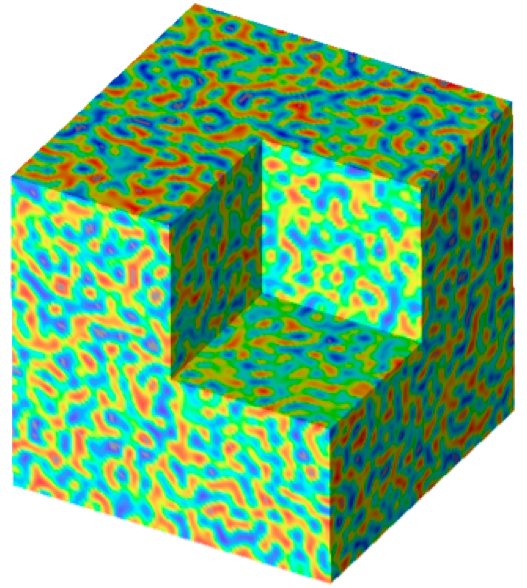examples.cahnHilliard.mesh3D¶
Solves the Cahn-Hilliard problem in a 3D cube
>>> from fipy import CellVariable, Grid3D, Viewer, GaussianNoiseVariable, TransientTerm, DiffusionTerm, DefaultSolver
>>> from fipy.tools import numerix
The only difference from examples.cahnHilliard.mesh2D is the
declaration of mesh.
>>> if __name__ == "__main__":
... nx = ny = nz = 100
... else:
... nx = ny = nz = 10
>>> mesh = Grid3D(nx=nx, ny=ny, nz=nz, dx=0.25, dy=0.25, dz=0.25)
>>> phi = CellVariable(name=r"$\phi$", mesh=mesh)
We start the problem with random fluctuations about \(\phi = 1/2\)
>>> phi.setValue(GaussianNoiseVariable(mesh=mesh,
... mean=0.5,
... variance=0.01))
FiPy doesn’t plot or output anything unless you tell it to:
>>> if __name__ == "__main__":
... viewer = Viewer(vars=(phi,), datamin=0., datamax=1.)
For FiPy, we need to perform the partial derivative
\(\partial f/\partial \phi\)
manually and then put the equation in the canonical
form by decomposing the spatial derivatives
so that each Term is of a single, even order:
FiPy would automatically interpolate
D * a**2 * (1 - 6 * phi * (1 - phi))
onto the faces, where the diffusive flux is calculated, but we obtain
somewhat more accurate results by performing a linear interpolation from
phi at cell centers to PHI at face centers.
Some problems benefit from non-linear interpolations, such as harmonic or
geometric means, and FiPy makes it easy to obtain these, too.
>>> PHI = phi.arithmeticFaceValue
>>> D = a = epsilon = 1.
>>> eq = (TransientTerm()
... == DiffusionTerm(coeff=D * a**2 * (1 - 6 * PHI * (1 - PHI)))
... - DiffusionTerm(coeff=(D, epsilon**2)))
Because the evolution of a spinodal microstructure slows with time, we use exponentially increasing time steps to keep the simulation “interesting”. The FiPy user always has direct control over the evolution of their problem.
>>> dexp = -5
>>> elapsed = 0.
>>> if __name__ == "__main__":
... duration = 1000.
... else:
... duration = 1e-2
>>> while elapsed < duration:
... dt = min(100, numerix.exp(dexp))
... elapsed += dt
... dexp += 0.01
... eq.solve(phi, dt=dt, solver=DefaultSolver(precon=None))
... if __name__ == "__main__":
... viewer.plot()

 FiPy
FiPy